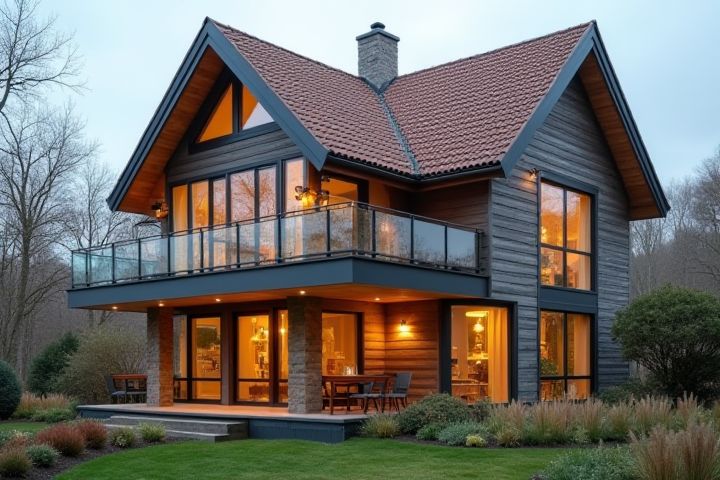
An energy-efficient house minimizes energy consumption while maintaining comfort and functionality. Incorporating high-quality insulation reduces heat loss in winter and keeps the interior cool in summer. Energy-efficient windows, often double or triple-glazed, prevent drafts and reduce the need for heating or cooling systems. Utilizing renewable energy sources, such as solar panels, can cut electricity costs and lower your carbon footprint. Smart home technology further enhances efficiency by allowing you to monitor and optimize energy use in real-time.
Why Is A House Energy-Efficient
Improved Insulation
Improved insulation is crucial for a house's energy efficiency as it significantly reduces thermal transfer between the interior and exterior environments. High-quality insulation materials, such as spray foam or fiberglass, help maintain a consistent indoor temperature, minimizing the need for heating and cooling systems to work overtime. This not only lowers energy bills but also decreases your carbon footprint by reducing greenhouse gas emissions from energy production. Overall, well-insulated homes contribute to a more sustainable living environment while enhancing comfort and reducing noise pollution.
Energy-Efficient Windows
Energy-efficient windows significantly reduce heat transfer, ensuring that your home maintains a comfortable temperature year-round. These windows typically feature double or triple glazing, low-emissivity (Low-E) coatings, and gas fills like argon to enhance insulation. By minimizing air leakage, energy-efficient windows prevent drafts, leading to lower heating and cooling costs. Investing in such windows not only decreases your carbon footprint but also contributes to a more sustainable living environment.
High-Quality Roofing Materials
A house becomes energy-efficient when it features high-quality roofing materials that offer superior insulation and durability. These materials, such as cool roofing, metal, or clay tiles, reflect sunlight, reducing heat absorption and minimizing cooling costs during hot months. In addition, high-quality roofing enhances weather resistance, reducing the likelihood of leaks or damage that can lead to energy loss. By investing in robust roofing solutions, you can maintain a stable indoor temperature, ultimately leading to significant energy savings and a smaller carbon footprint for your home.
Energy-Star Appliances
Energy-efficient homes incorporate Energy Star appliances to significantly reduce energy consumption and utility costs. These appliances meet strict efficiency guidelines set by the U.S. Environmental Protection Agency, using up to 50% less energy than standard models. For instance, an Energy Star certified refrigerator can save you as much as $300 over its lifetime, translating to lower monthly bills while minimizing environmental impact. By choosing these efficient options, homeowners not only enhance comfort but also contribute to a sustainable future.
LED Lighting
LED lighting significantly contributes to a house's energy efficiency by consuming up to 75% less energy than traditional incandescent bulbs. These long-lasting lights can provide the same illumination with a fraction of the energy output, resulting in reduced electricity bills. Moreover, LED bulbs emit less heat, which helps maintain a comfortable indoor temperature and minimizes reliance on air conditioning. By incorporating LED lighting into your home, you enhance sustainability while lowering your carbon footprint.
Efficient HVAC Systems
An energy-efficient house incorporates efficient HVAC systems to minimize energy consumption while maximizing comfort. These systems, such as variable-speed air conditioners and energy recovery ventilation, ensure optimal temperature control and improved air quality throughout your home. By utilizing programmable thermostats, you can further enhance energy savings by automatically adjusting heating and cooling settings based on your routines. Investing in high-efficiency HVAC units not only reduces utility bills but also lowers your carbon footprint and contributes to a more sustainable environment.
Solar Panels
A house can achieve significant energy efficiency by incorporating solar panels, which convert sunlight into renewable energy. Solar panels can reduce electricity bills by up to 70%, depending on your location and energy consumption. With advancements in technology, the efficiency of solar panels has increased to around 20% or more, maximizing energy capture. You can also benefit from various incentives, such as tax credits and rebates, which can further offset the initial installation costs, making solar an economical choice.
Smart Home Technology
A house becomes energy-efficient through the integration of Smart Home Technology, which encompasses devices and systems that optimize energy use. Smart thermostats, such as Nest or Ecobee, automatically adjust heating and cooling based on your habits, reducing energy consumption significantly. Smart lighting systems, like Philips Hue, allow for remote control and automation, ensuring lights are only on when needed, further saving electricity. By utilizing energy-efficient appliances connected to a smart hub, you can monitor and manage your overall energy use, leading to reduced utility bills and a smaller carbon footprint.
Proper Sealing and Ventilation
Proper sealing and ventilation are crucial for creating an energy-efficient house, as they significantly reduce air leaks that can cause energy loss. By sealing gaps, cracks, and openings, you minimize the infiltration of outside air, leading to more consistent indoor temperatures and reduced reliance on heating and cooling systems. Effective ventilation ensures a continuous flow of fresh air, improving indoor air quality while preventing moisture buildup and mold growth. This optimized approach not only lowers your energy bills but also contributes to a healthier and more comfortable living environment.
Efficient Water Heating Systems
An energy-efficient house often incorporates efficient water heating systems, which can reduce energy consumption by up to 50%. Tankless water heaters, for example, provide hot water on demand and eliminate standby heat loss, making them a popular choice for energy-conscious homeowners. Solar water heating systems can further decrease utility bills, harnessing sunlight to generate hot water while potentially saving up to $2,000 annually on energy costs. By selecting high-efficiency models, you not only lower your environmental impact but also increase the overall comfort and value of your home.
